Cultural Safety Australia Research Paper 2022
VerifiedAdded on 2022/09/27
|7
|2031
|33
AI Summary
Contribute Materials
Your contribution can guide someone’s learning journey. Share your
documents today.

Running head: CULTURAL SAFETY 1
Cultural Safety
Student’s name
Institutional affiliation
Due date
Cultural Safety
Student’s name
Institutional affiliation
Due date
Secure Best Marks with AI Grader
Need help grading? Try our AI Grader for instant feedback on your assignments.
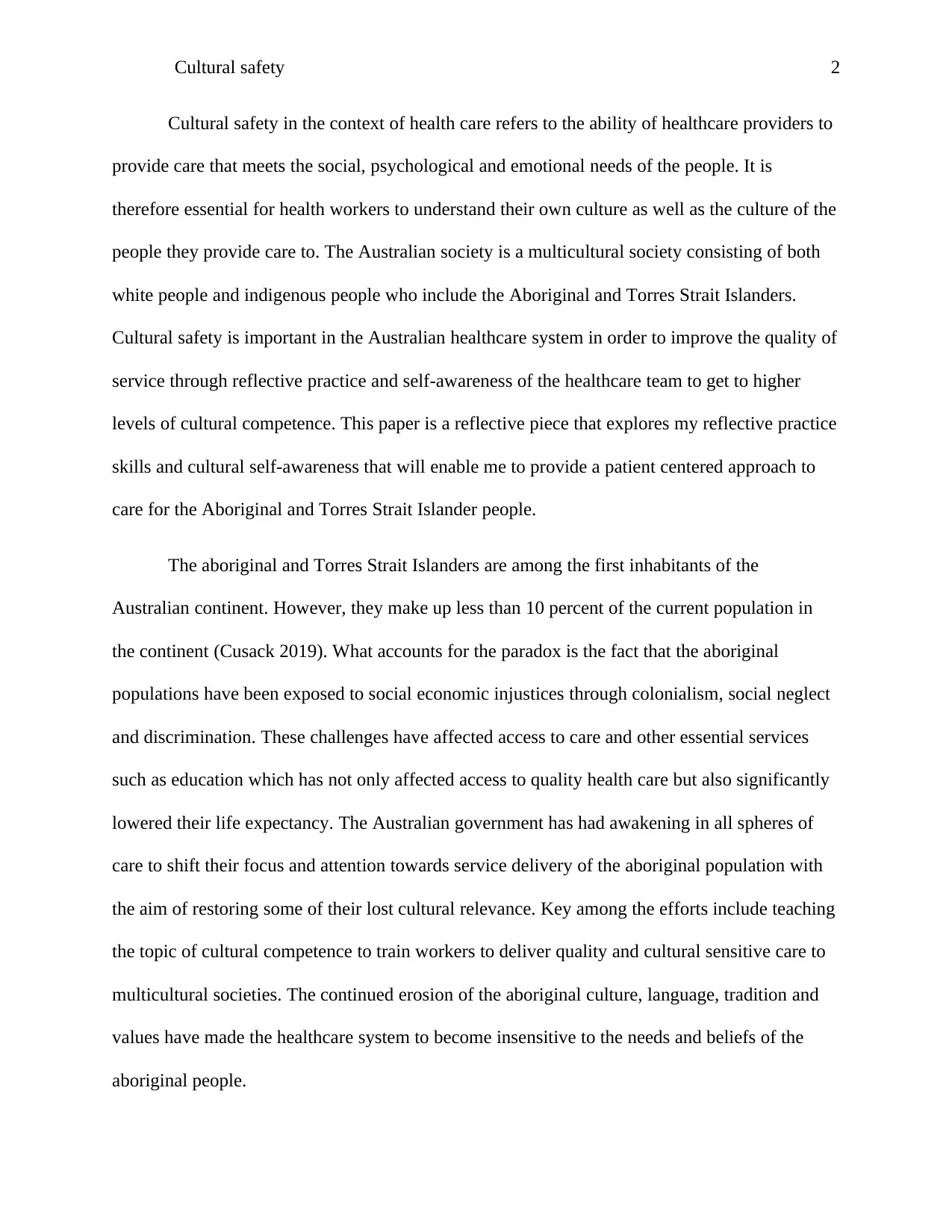
Cultural safety 2
Cultural safety in the context of health care refers to the ability of healthcare providers to
provide care that meets the social, psychological and emotional needs of the people. It is
therefore essential for health workers to understand their own culture as well as the culture of the
people they provide care to. The Australian society is a multicultural society consisting of both
white people and indigenous people who include the Aboriginal and Torres Strait Islanders.
Cultural safety is important in the Australian healthcare system in order to improve the quality of
service through reflective practice and self-awareness of the healthcare team to get to higher
levels of cultural competence. This paper is a reflective piece that explores my reflective practice
skills and cultural self-awareness that will enable me to provide a patient centered approach to
care for the Aboriginal and Torres Strait Islander people.
The aboriginal and Torres Strait Islanders are among the first inhabitants of the
Australian continent. However, they make up less than 10 percent of the current population in
the continent (Cusack 2019). What accounts for the paradox is the fact that the aboriginal
populations have been exposed to social economic injustices through colonialism, social neglect
and discrimination. These challenges have affected access to care and other essential services
such as education which has not only affected access to quality health care but also significantly
lowered their life expectancy. The Australian government has had awakening in all spheres of
care to shift their focus and attention towards service delivery of the aboriginal population with
the aim of restoring some of their lost cultural relevance. Key among the efforts include teaching
the topic of cultural competence to train workers to deliver quality and cultural sensitive care to
multicultural societies. The continued erosion of the aboriginal culture, language, tradition and
values have made the healthcare system to become insensitive to the needs and beliefs of the
aboriginal people.
Cultural safety in the context of health care refers to the ability of healthcare providers to
provide care that meets the social, psychological and emotional needs of the people. It is
therefore essential for health workers to understand their own culture as well as the culture of the
people they provide care to. The Australian society is a multicultural society consisting of both
white people and indigenous people who include the Aboriginal and Torres Strait Islanders.
Cultural safety is important in the Australian healthcare system in order to improve the quality of
service through reflective practice and self-awareness of the healthcare team to get to higher
levels of cultural competence. This paper is a reflective piece that explores my reflective practice
skills and cultural self-awareness that will enable me to provide a patient centered approach to
care for the Aboriginal and Torres Strait Islander people.
The aboriginal and Torres Strait Islanders are among the first inhabitants of the
Australian continent. However, they make up less than 10 percent of the current population in
the continent (Cusack 2019). What accounts for the paradox is the fact that the aboriginal
populations have been exposed to social economic injustices through colonialism, social neglect
and discrimination. These challenges have affected access to care and other essential services
such as education which has not only affected access to quality health care but also significantly
lowered their life expectancy. The Australian government has had awakening in all spheres of
care to shift their focus and attention towards service delivery of the aboriginal population with
the aim of restoring some of their lost cultural relevance. Key among the efforts include teaching
the topic of cultural competence to train workers to deliver quality and cultural sensitive care to
multicultural societies. The continued erosion of the aboriginal culture, language, tradition and
values have made the healthcare system to become insensitive to the needs and beliefs of the
aboriginal people.
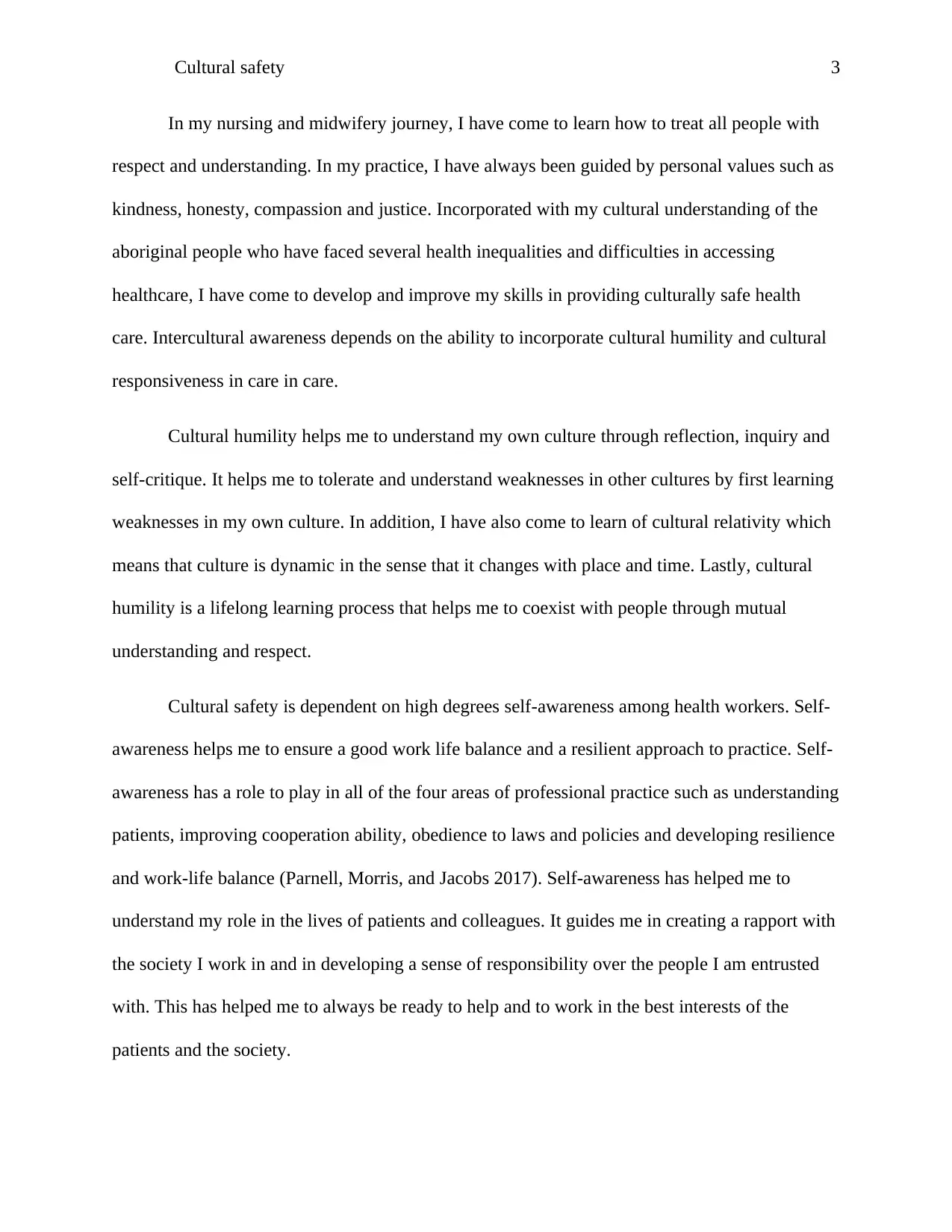
Cultural safety 3
In my nursing and midwifery journey, I have come to learn how to treat all people with
respect and understanding. In my practice, I have always been guided by personal values such as
kindness, honesty, compassion and justice. Incorporated with my cultural understanding of the
aboriginal people who have faced several health inequalities and difficulties in accessing
healthcare, I have come to develop and improve my skills in providing culturally safe health
care. Intercultural awareness depends on the ability to incorporate cultural humility and cultural
responsiveness in care in care.
Cultural humility helps me to understand my own culture through reflection, inquiry and
self-critique. It helps me to tolerate and understand weaknesses in other cultures by first learning
weaknesses in my own culture. In addition, I have also come to learn of cultural relativity which
means that culture is dynamic in the sense that it changes with place and time. Lastly, cultural
humility is a lifelong learning process that helps me to coexist with people through mutual
understanding and respect.
Cultural safety is dependent on high degrees self-awareness among health workers. Self-
awareness helps me to ensure a good work life balance and a resilient approach to practice. Self-
awareness has a role to play in all of the four areas of professional practice such as understanding
patients, improving cooperation ability, obedience to laws and policies and developing resilience
and work-life balance (Parnell, Morris, and Jacobs 2017). Self-awareness has helped me to
understand my role in the lives of patients and colleagues. It guides me in creating a rapport with
the society I work in and in developing a sense of responsibility over the people I am entrusted
with. This has helped me to always be ready to help and to work in the best interests of the
patients and the society.
In my nursing and midwifery journey, I have come to learn how to treat all people with
respect and understanding. In my practice, I have always been guided by personal values such as
kindness, honesty, compassion and justice. Incorporated with my cultural understanding of the
aboriginal people who have faced several health inequalities and difficulties in accessing
healthcare, I have come to develop and improve my skills in providing culturally safe health
care. Intercultural awareness depends on the ability to incorporate cultural humility and cultural
responsiveness in care in care.
Cultural humility helps me to understand my own culture through reflection, inquiry and
self-critique. It helps me to tolerate and understand weaknesses in other cultures by first learning
weaknesses in my own culture. In addition, I have also come to learn of cultural relativity which
means that culture is dynamic in the sense that it changes with place and time. Lastly, cultural
humility is a lifelong learning process that helps me to coexist with people through mutual
understanding and respect.
Cultural safety is dependent on high degrees self-awareness among health workers. Self-
awareness helps me to ensure a good work life balance and a resilient approach to practice. Self-
awareness has a role to play in all of the four areas of professional practice such as understanding
patients, improving cooperation ability, obedience to laws and policies and developing resilience
and work-life balance (Parnell, Morris, and Jacobs 2017). Self-awareness has helped me to
understand my role in the lives of patients and colleagues. It guides me in creating a rapport with
the society I work in and in developing a sense of responsibility over the people I am entrusted
with. This has helped me to always be ready to help and to work in the best interests of the
patients and the society.

Cultural safety 4
Self-awareness has also helped me to improve on my cooperation and collaborative
efforts. With improved self-awareness, I am are able to develop respect for others in their
different areas of specialty which helps us to work without colliding or burdening others with my
responsibilities. Besides, I have also develop competence and interest in sharing my knowledge
and experiences in order to help other nurses and aboriginal people. In addition, it has helped me
not to look down on others because of their inefficiencies but to do my best to support them and
guide them. Lastly has helped me to seek the support of experienced colleagues to develop my
skills using the crystallized intelligence acquired from many years of practice from fellow
healthcare providers.
Self-awareness has helped me in my efforts to practice with regard to the set policies,
processes, standards, norms, values and codes of professional practice. In regard to this, it helps
me to know what to do and when to do it. This is important when I am faced with ethical
dilemmas and when I am faced by situations that require hard choices to make. Self-awareness
helps develop other skills that may be instrumental in sharpening the leadership skills and
helping nurses to make informed decisions. Lastly, it also helps nurses to be diligent and orderly
in keeping health records and observing associated values such as confidentiality. Self-awareness
trains a nurse to understand how to balance work life and having a resilient approach to clinical
practice and care (Kruske, Kildea, and Barclay 2006).
Through the course, I have also learned various ways through which I can cultivate
several cultural attributes that would help to improve cultural safety for the Aboriginal and
Torres Strait Islanders. These include elimination of bias and stereotypes, building healthy
relationships, reflection of people and profession as well as cultural immersion programs
(Fredericks 2006). In addition, cultivating certain skills such as moral courage and emotional
Self-awareness has also helped me to improve on my cooperation and collaborative
efforts. With improved self-awareness, I am are able to develop respect for others in their
different areas of specialty which helps us to work without colliding or burdening others with my
responsibilities. Besides, I have also develop competence and interest in sharing my knowledge
and experiences in order to help other nurses and aboriginal people. In addition, it has helped me
not to look down on others because of their inefficiencies but to do my best to support them and
guide them. Lastly has helped me to seek the support of experienced colleagues to develop my
skills using the crystallized intelligence acquired from many years of practice from fellow
healthcare providers.
Self-awareness has helped me in my efforts to practice with regard to the set policies,
processes, standards, norms, values and codes of professional practice. In regard to this, it helps
me to know what to do and when to do it. This is important when I am faced with ethical
dilemmas and when I am faced by situations that require hard choices to make. Self-awareness
helps develop other skills that may be instrumental in sharpening the leadership skills and
helping nurses to make informed decisions. Lastly, it also helps nurses to be diligent and orderly
in keeping health records and observing associated values such as confidentiality. Self-awareness
trains a nurse to understand how to balance work life and having a resilient approach to clinical
practice and care (Kruske, Kildea, and Barclay 2006).
Through the course, I have also learned various ways through which I can cultivate
several cultural attributes that would help to improve cultural safety for the Aboriginal and
Torres Strait Islanders. These include elimination of bias and stereotypes, building healthy
relationships, reflection of people and profession as well as cultural immersion programs
(Fredericks 2006). In addition, cultivating certain skills such as moral courage and emotional
Secure Best Marks with AI Grader
Need help grading? Try our AI Grader for instant feedback on your assignments.
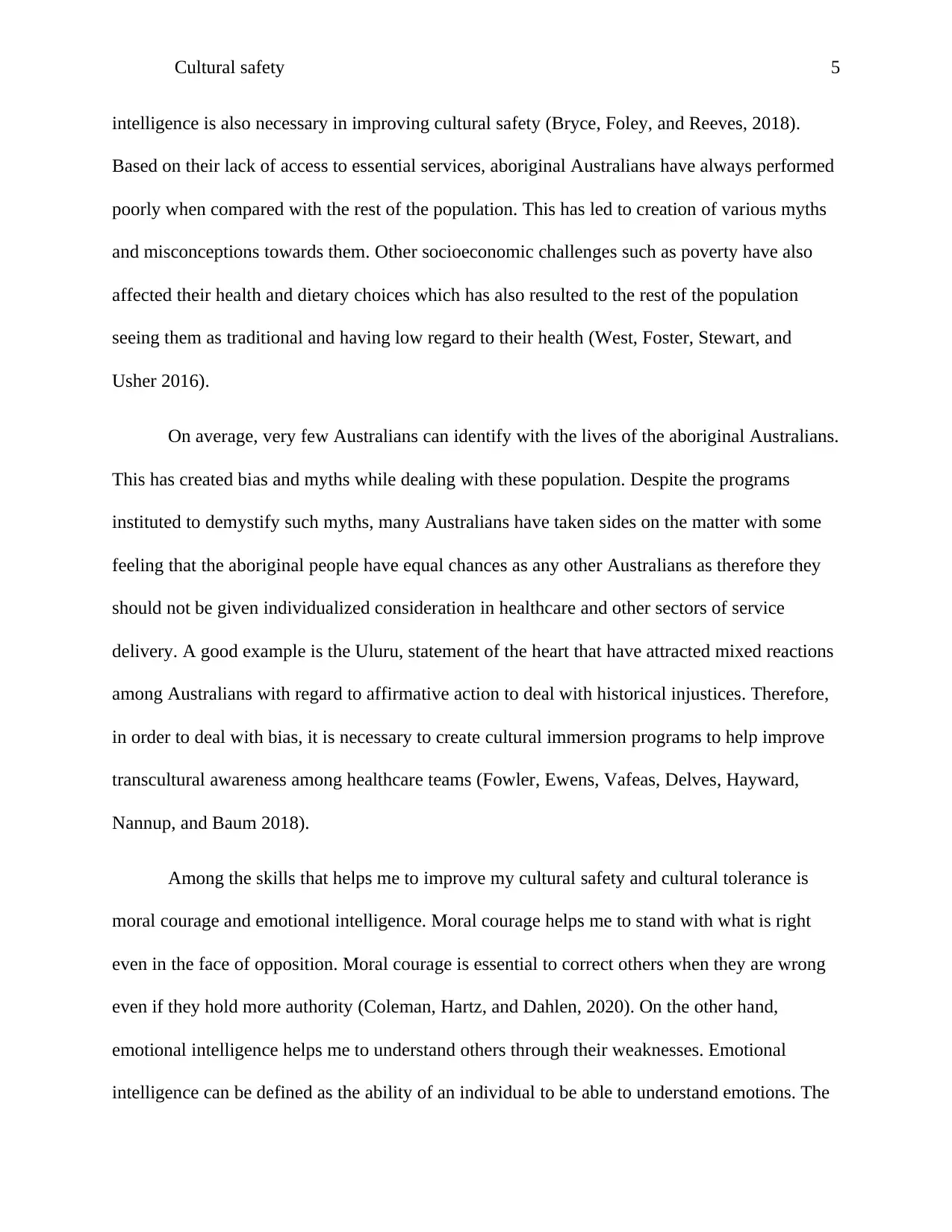
Cultural safety 5
intelligence is also necessary in improving cultural safety (Bryce, Foley, and Reeves, 2018).
Based on their lack of access to essential services, aboriginal Australians have always performed
poorly when compared with the rest of the population. This has led to creation of various myths
and misconceptions towards them. Other socioeconomic challenges such as poverty have also
affected their health and dietary choices which has also resulted to the rest of the population
seeing them as traditional and having low regard to their health (West, Foster, Stewart, and
Usher 2016).
On average, very few Australians can identify with the lives of the aboriginal Australians.
This has created bias and myths while dealing with these population. Despite the programs
instituted to demystify such myths, many Australians have taken sides on the matter with some
feeling that the aboriginal people have equal chances as any other Australians as therefore they
should not be given individualized consideration in healthcare and other sectors of service
delivery. A good example is the Uluru, statement of the heart that have attracted mixed reactions
among Australians with regard to affirmative action to deal with historical injustices. Therefore,
in order to deal with bias, it is necessary to create cultural immersion programs to help improve
transcultural awareness among healthcare teams (Fowler, Ewens, Vafeas, Delves, Hayward,
Nannup, and Baum 2018).
Among the skills that helps me to improve my cultural safety and cultural tolerance is
moral courage and emotional intelligence. Moral courage helps me to stand with what is right
even in the face of opposition. Moral courage is essential to correct others when they are wrong
even if they hold more authority (Coleman, Hartz, and Dahlen, 2020). On the other hand,
emotional intelligence helps me to understand others through their weaknesses. Emotional
intelligence can be defined as the ability of an individual to be able to understand emotions. The
intelligence is also necessary in improving cultural safety (Bryce, Foley, and Reeves, 2018).
Based on their lack of access to essential services, aboriginal Australians have always performed
poorly when compared with the rest of the population. This has led to creation of various myths
and misconceptions towards them. Other socioeconomic challenges such as poverty have also
affected their health and dietary choices which has also resulted to the rest of the population
seeing them as traditional and having low regard to their health (West, Foster, Stewart, and
Usher 2016).
On average, very few Australians can identify with the lives of the aboriginal Australians.
This has created bias and myths while dealing with these population. Despite the programs
instituted to demystify such myths, many Australians have taken sides on the matter with some
feeling that the aboriginal people have equal chances as any other Australians as therefore they
should not be given individualized consideration in healthcare and other sectors of service
delivery. A good example is the Uluru, statement of the heart that have attracted mixed reactions
among Australians with regard to affirmative action to deal with historical injustices. Therefore,
in order to deal with bias, it is necessary to create cultural immersion programs to help improve
transcultural awareness among healthcare teams (Fowler, Ewens, Vafeas, Delves, Hayward,
Nannup, and Baum 2018).
Among the skills that helps me to improve my cultural safety and cultural tolerance is
moral courage and emotional intelligence. Moral courage helps me to stand with what is right
even in the face of opposition. Moral courage is essential to correct others when they are wrong
even if they hold more authority (Coleman, Hartz, and Dahlen, 2020). On the other hand,
emotional intelligence helps me to understand others through their weaknesses. Emotional
intelligence can be defined as the ability of an individual to be able to understand emotions. The
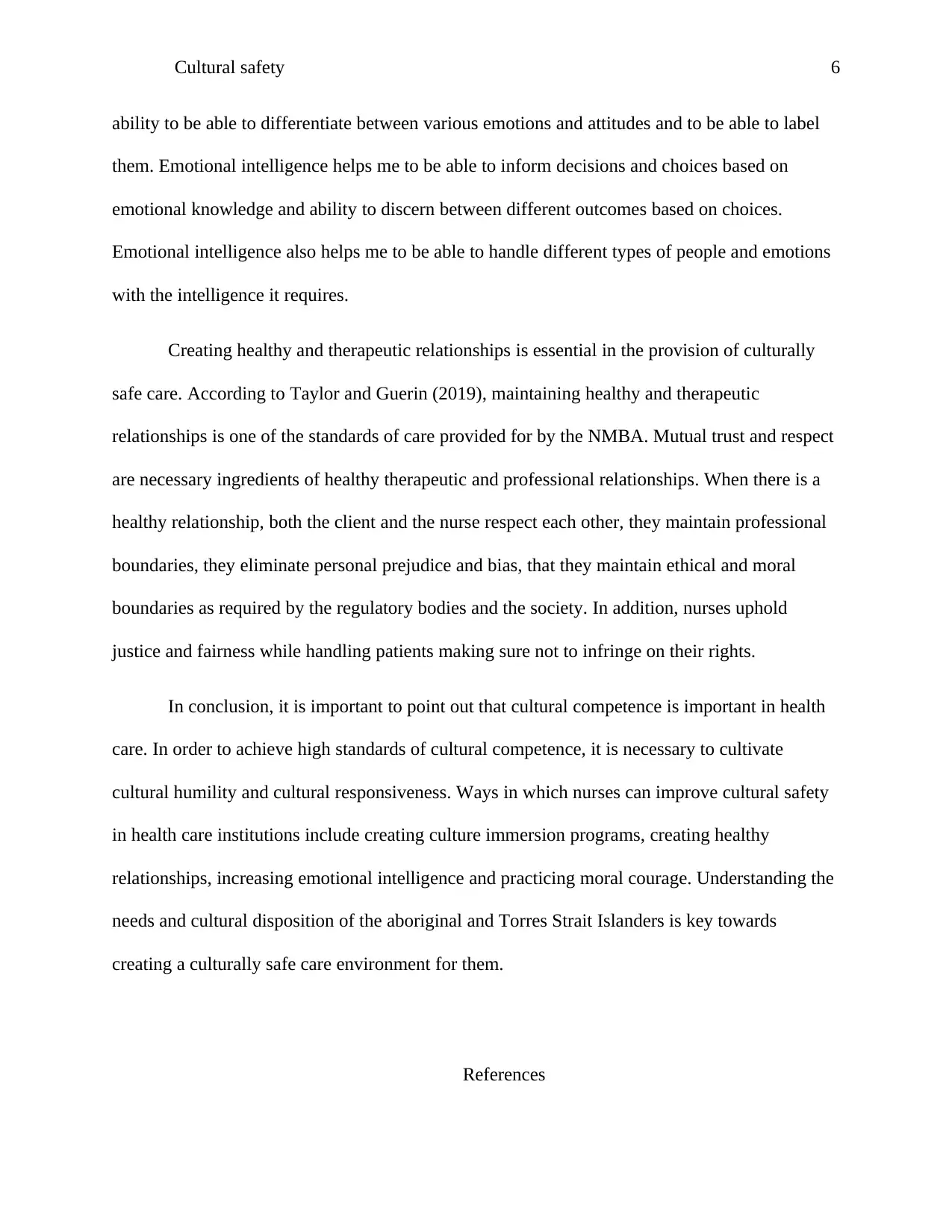
Cultural safety 6
ability to be able to differentiate between various emotions and attitudes and to be able to label
them. Emotional intelligence helps me to be able to inform decisions and choices based on
emotional knowledge and ability to discern between different outcomes based on choices.
Emotional intelligence also helps me to be able to handle different types of people and emotions
with the intelligence it requires.
Creating healthy and therapeutic relationships is essential in the provision of culturally
safe care. According to Taylor and Guerin (2019), maintaining healthy and therapeutic
relationships is one of the standards of care provided for by the NMBA. Mutual trust and respect
are necessary ingredients of healthy therapeutic and professional relationships. When there is a
healthy relationship, both the client and the nurse respect each other, they maintain professional
boundaries, they eliminate personal prejudice and bias, that they maintain ethical and moral
boundaries as required by the regulatory bodies and the society. In addition, nurses uphold
justice and fairness while handling patients making sure not to infringe on their rights.
In conclusion, it is important to point out that cultural competence is important in health
care. In order to achieve high standards of cultural competence, it is necessary to cultivate
cultural humility and cultural responsiveness. Ways in which nurses can improve cultural safety
in health care institutions include creating culture immersion programs, creating healthy
relationships, increasing emotional intelligence and practicing moral courage. Understanding the
needs and cultural disposition of the aboriginal and Torres Strait Islanders is key towards
creating a culturally safe care environment for them.
References
ability to be able to differentiate between various emotions and attitudes and to be able to label
them. Emotional intelligence helps me to be able to inform decisions and choices based on
emotional knowledge and ability to discern between different outcomes based on choices.
Emotional intelligence also helps me to be able to handle different types of people and emotions
with the intelligence it requires.
Creating healthy and therapeutic relationships is essential in the provision of culturally
safe care. According to Taylor and Guerin (2019), maintaining healthy and therapeutic
relationships is one of the standards of care provided for by the NMBA. Mutual trust and respect
are necessary ingredients of healthy therapeutic and professional relationships. When there is a
healthy relationship, both the client and the nurse respect each other, they maintain professional
boundaries, they eliminate personal prejudice and bias, that they maintain ethical and moral
boundaries as required by the regulatory bodies and the society. In addition, nurses uphold
justice and fairness while handling patients making sure not to infringe on their rights.
In conclusion, it is important to point out that cultural competence is important in health
care. In order to achieve high standards of cultural competence, it is necessary to cultivate
cultural humility and cultural responsiveness. Ways in which nurses can improve cultural safety
in health care institutions include creating culture immersion programs, creating healthy
relationships, increasing emotional intelligence and practicing moral courage. Understanding the
needs and cultural disposition of the aboriginal and Torres Strait Islanders is key towards
creating a culturally safe care environment for them.
References
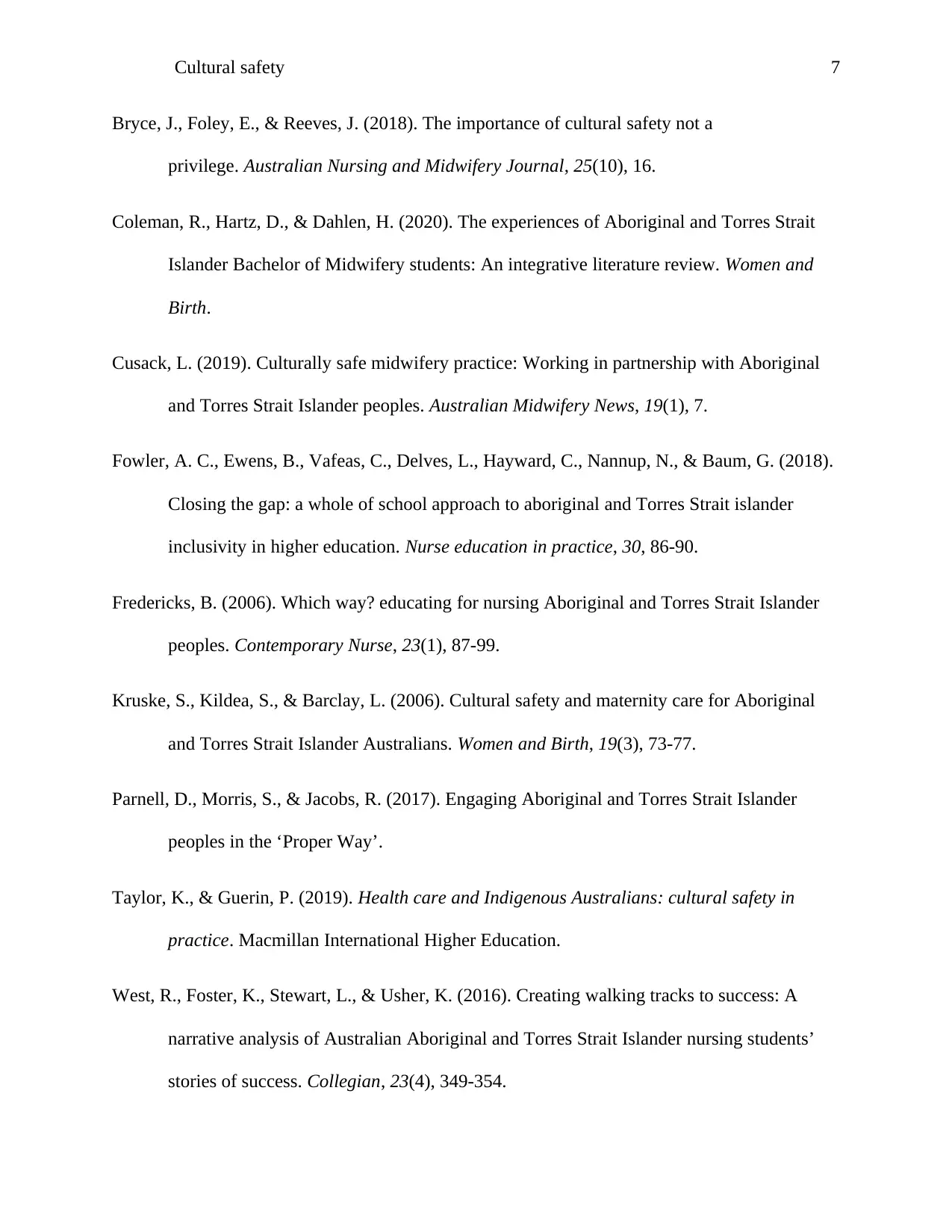
Cultural safety 7
Bryce, J., Foley, E., & Reeves, J. (2018). The importance of cultural safety not a
privilege. Australian Nursing and Midwifery Journal, 25(10), 16.
Coleman, R., Hartz, D., & Dahlen, H. (2020). The experiences of Aboriginal and Torres Strait
Islander Bachelor of Midwifery students: An integrative literature review. Women and
Birth.
Cusack, L. (2019). Culturally safe midwifery practice: Working in partnership with Aboriginal
and Torres Strait Islander peoples. Australian Midwifery News, 19(1), 7.
Fowler, A. C., Ewens, B., Vafeas, C., Delves, L., Hayward, C., Nannup, N., & Baum, G. (2018).
Closing the gap: a whole of school approach to aboriginal and Torres Strait islander
inclusivity in higher education. Nurse education in practice, 30, 86-90.
Fredericks, B. (2006). Which way? educating for nursing Aboriginal and Torres Strait Islander
peoples. Contemporary Nurse, 23(1), 87-99.
Kruske, S., Kildea, S., & Barclay, L. (2006). Cultural safety and maternity care for Aboriginal
and Torres Strait Islander Australians. Women and Birth, 19(3), 73-77.
Parnell, D., Morris, S., & Jacobs, R. (2017). Engaging Aboriginal and Torres Strait Islander
peoples in the ‘Proper Way’.
Taylor, K., & Guerin, P. (2019). Health care and Indigenous Australians: cultural safety in
practice. Macmillan International Higher Education.
West, R., Foster, K., Stewart, L., & Usher, K. (2016). Creating walking tracks to success: A
narrative analysis of Australian Aboriginal and Torres Strait Islander nursing students’
stories of success. Collegian, 23(4), 349-354.
Bryce, J., Foley, E., & Reeves, J. (2018). The importance of cultural safety not a
privilege. Australian Nursing and Midwifery Journal, 25(10), 16.
Coleman, R., Hartz, D., & Dahlen, H. (2020). The experiences of Aboriginal and Torres Strait
Islander Bachelor of Midwifery students: An integrative literature review. Women and
Birth.
Cusack, L. (2019). Culturally safe midwifery practice: Working in partnership with Aboriginal
and Torres Strait Islander peoples. Australian Midwifery News, 19(1), 7.
Fowler, A. C., Ewens, B., Vafeas, C., Delves, L., Hayward, C., Nannup, N., & Baum, G. (2018).
Closing the gap: a whole of school approach to aboriginal and Torres Strait islander
inclusivity in higher education. Nurse education in practice, 30, 86-90.
Fredericks, B. (2006). Which way? educating for nursing Aboriginal and Torres Strait Islander
peoples. Contemporary Nurse, 23(1), 87-99.
Kruske, S., Kildea, S., & Barclay, L. (2006). Cultural safety and maternity care for Aboriginal
and Torres Strait Islander Australians. Women and Birth, 19(3), 73-77.
Parnell, D., Morris, S., & Jacobs, R. (2017). Engaging Aboriginal and Torres Strait Islander
peoples in the ‘Proper Way’.
Taylor, K., & Guerin, P. (2019). Health care and Indigenous Australians: cultural safety in
practice. Macmillan International Higher Education.
West, R., Foster, K., Stewart, L., & Usher, K. (2016). Creating walking tracks to success: A
narrative analysis of Australian Aboriginal and Torres Strait Islander nursing students’
stories of success. Collegian, 23(4), 349-354.
1 out of 7
Related Documents
Your All-in-One AI-Powered Toolkit for Academic Success.
+13062052269
info@desklib.com
Available 24*7 on WhatsApp / Email
![[object Object]](/_next/static/media/star-bottom.7253800d.svg)
Unlock your academic potential
© 2024 | Zucol Services PVT LTD | All rights reserved.





